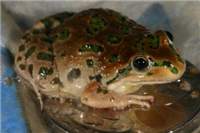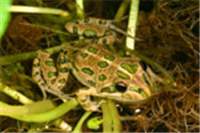Family
MyobatrachidaeGenus
LymnodynastesSpecies
tasmaniensis
Threats/Control Methods - Local
Within the A.C.T the largest threat to the species is the loss of habitat through urbanisation. Despite L.tasmeniensis not currently being considered at risk, care should be taken at all times when entering frog habitats due to the risk of spreading disease, including the Chytrid fungus (chytridiomycosis). To prevent the spread of the Chytrid fungus it is important to wash your shoes before entering and after leaving frog habitats. For more information on the Chytrid fungus © Link to fact sheet http://www.deh.gov.au/biodiversity/invasive/publications/c-disease/ Frogs drink and breathe through their skin and are very sensitive to chemicals in their environment. Where possible, you should not handle frogs, as the natural bacteria on your hands or chemicals such as sunscreen can damage their skin and cause illness or death.Local/Urban Actions
Making Frog friendly gardens provides frogs such as L.tasmaniensis with new habitats, helping to replace those lost through urbanisation. The Ginninderra Catchment Group, Australian National University and Environment ACT have developed a guideline to help you encourage frogs into your backyard called Creating a Frog Friendly Habitat in the ACT Community.
You can also get involved in monitoring local frog populations. Frogwatch is an annual program run to monitor the presence and abundance of frogs within the ACT region. The Frogwatch program provides training for community volunteers each October, with monitoring then being undertaken by volunteers over a two week period.
For more information on Frogwatch contact:The ACT Frogwatch Coordinator, Ginninderra Catchment Group; Ph (02) 6278 3309 or email: [email protected]
Distinguishing Features
Around 4.5-5cm in length with a distinctive red/orange/yellow/white stripe running down the centre of the back; a raised pale yellow-cream stripe running from the eye to the top of the arm; back covered with darker splotches. The call resembles a ©kuk uk uk uk©, similar that to the noise made by a toy machine gun. Tadpoles range from olive-grey to brown-grey to black depending upon the clarity of the surrounding water.
Common name/s
Spotted grass frog, Spotted marsh frog.
Distribution
Occurs throughout most of eastern Australia, from Queensland through to N.S.W, Victoria, the eastern edge of South Australia, and Tasmania. There is also an introduced population present in Kununurra of West Australia.
Country of Origin
Australia
Survey Techniques
The most common technique for monitoring frog populations is based on call identification, with each frog species having a unique call. Frogs should not be handled without the use of sterile gloves, as their skin is very sensitive to chemicals, including soap and sunscreen. For more information see Local Actions below.
Conservation (Pet/Pest) Status - National
Not thought to be at risk
Conservation (Pet/Pest) Status - Regional
Not thought to be at risk
LSCCES Population
In the 2004 Frogwatch census this species was detected in 67% of the sites. Locally this species is not thought to be at risk.
Associated Vegetation Community
A variety of habitats are associated with this species including woodland, shrubland, and grassland. Frogs are usually found near water bodies under rocks or reeds.
Limiting Resources
Rocks and reeds provide important habitat and shelter
Breeding
Calls can be heard from September to March. Breeding occurs throughout most of the year, from August to March. The eggs are laid in a floating foam nest around 5-8cm in diameter, with up to 1500 eggs.
Behaviour
Adults can often be found under shelter such as logs or rocks near water edges. Males call while floating in the water or from the waters edge.
Functional Group
Insectivorous
Food Species
Small invertebrates such as beetles, spiders and centipedes.
Predators
May include native birds, such as the White-Faced Heron (Egretta novaehollandiae) and Intermediate Egret, and fish, including the introduced Carp, Goldfish and Trout. Introduced species such as Cats (Felis catus) and Foxes may also predate on frogs.
Interesting Fact
The call of the species differs slightly between northern and southern populations. The northern population has a slightly longer and more complex call, composed of many short calls.
References - (reader suitability of references, P=Primary teachers, S=Secondary students, T=Tertiary students and researchers)
Books:
Barker, J., Grigg,G., Tyler, M. (1995). A Field Guide to Australian Frogs. Surry Beatty & Sons. NSW, Australia. S, TLintermans,M. & Osborne, W. (2002). Wet & Wild: A Field Guide to the Freshwater Animals of the Southern Tablelands and High Country of the ACT and NSW. Environment ACT. Canberra, Australia. S, TRobinson, M. (1993). A Field Guide to Frogs of Australia. Australian Museum/Reed books. NSW, Australia. S, TTurner, J. (2004). Frogs of Australia. Pensoft. Bulgaria. P, STyler, J. (1994). Australian Frogs: A Natural History. Reed New Holland. Australia. S, TSwan, G.(2001). Green Guide: Frogs of Australia. New Holland Publishers. Sydney, Australia. P, S
Online Publications:
Amphibian Research Centre. (2005). Available Online: http://frogs.org.au/frogs/species/Lymnodynastes/tasmaniensis/ S, TAustralian Frogs Database.(2005). Available Online: http://frogsaustralia.net.au/frogs/display.cfm?frog_id=43 S, TDepartment of Environment and Heritage, (2004). Chytridiomycosis Factsheet http://www.deh.gov.au/biodiversity/invasive/publications/c-disease/ S, TZoological Parks and Gardens Board. Frog Pond Checklist. Available Online: http://www.zoo.org.au/education/factsheets/amp-frog_pond_checklist.pdf P, S, TSpeare, R et al (1998). HOW TO REDUCE THE RISKS OF YOU TRANSMITTING AN INFECTIOUS AGENT BETWEEN FROGS AND BETWEEN SITES. Available Online: http://www.jcu.edu.au/school/phtm/PHTM/frogs/prevent.htm S, T"Environment ACT (2004). Available online: http://www.environment.act.gov.au/Files/frogwatchoctober2004-limnodynastestasmaniensiresults.pdf S, T"Zoological Parks Board N>S>W. (2005.). ASX Frog Focus. Available online: http://www.asxfrogfocus.com/ P, S (School activity program)
Researcher: Pippa Jaminon



 Top
Top Top
Top